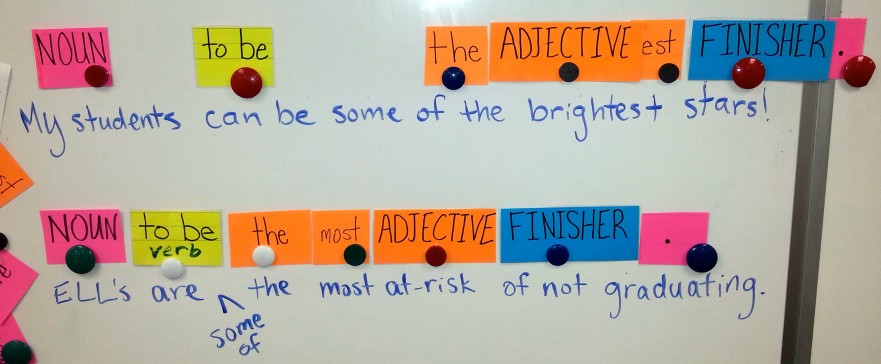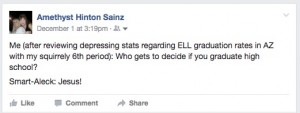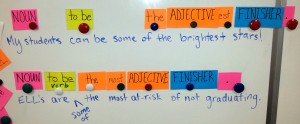Snippets of surreptitious conversational Spanish dart around the classroom amid scattered outbursts of giggles. I review the color-coded highlighting of sentence parts in our newest sentence formula involving superlative adjectives, pointing to the laminated neon cards magneted to the board. A final few students finish highlighting their notes and we move into examples, but between my sentences I am waiting much too long for their attention. It is one of those days in 6th period ELD Grammar when ten minutes of notes is about to become 20…or 25. I decide an intervention is in order and hold up my hand to ask for silent attention. While I am waiting, I decide what to say next.
I tell my junior high students that, looking around the room, I am worried about their futures. (The class quiets, mostly.) That the eighth graders only have two months until they take AZELLA, the test that will determine how many hours of English classes they will have in high school. That if they are taking two or four hours of English per day, as required by law until they pass AZELLA, it will limit their ability to take the classes they might choose, like music, auto shop or photography. That their hours in English Language Development classes could even limit their ability to take required classes. That if they can’t write a sentence that compares things, they will have a very hard time in many of their courses, including science, social studies and others. That grades count in high school, and if you fail a class, you have to take it again. I ask them if they realize how low the graduation rate is for Arizona ELL’s. I ask them to guess. 70%? 50%? I realize I don’t know the exact number, so we Google it.
According to EdWeek, in 2014 only 18% of Arizona’s English Language Learners graduated high school in four years. I doubt the number has increased much since then.
I do the math quickly on the board. If we follow the stats, only 3.34 students in this class are bound to graduate high school on time. They look around at each other, wondering who it will be. One bright young newcomer says, “It will be me!” At this point I am seriously doubting whether this conversation was a good idea. The outlook is profoundly frightening.*
Scrambling for hope, I dig a little deeper into that number, 3.34 students, saying that there is a good chance that more than three people in class will graduate, because so many of them are still in 7th grade, and they are already learning, and have four or five more years to pull it off, this barely-conceivable heist of learning English quickly and well enough to learn everything else. They have the opportunity to focus on the English language starting now, and get all they can. I ask them to think about the students who move here at 16 or 17 years old. I ask my class to think about whether, if they work hard this year, they might pass AZELLA, or move up a level, and be able to take some fun electives in high school, and graduate on time, or maintain eligibility and play high school sports. There is a lot of talking, and still some laughter, but they are thinking about it.
I tell them they can do it, but that they have to do the work it will take.
Up goes a hand. “Miss, will I graduate from high school?” Slight squeeze of my heart.
“How do I know?” I answer, and laugh. I ask the class, “Who decides if you graduate from high school? Who decides?”
The smart-aleck stage left blurts, “Jesus!” and the class dissolves into laughter. But maybe, with those numbers, a little prayer wouldn’t hurt.
Many, many factors affect whether I can teach my students what they will need to know to graduate on time. Looking back at my lecture and the faces before me in that class, I can’t help but wonder. Who or what does decide the fate of these students? Many of the decisions are in their hands alone; many are in mine; their parents bear great responsibility. Still, how will the decisions that are made outside the doors of this classroom, and outside of their homes, shape my students’ ability to move forward?
To be continued…
*All of this is happening with intermittent pauses so that I, our classroom tech, or another student can translate key items into Spanish now and then for the beginners. This class includes 24 students from pre-emergent through high intermediate levels of English proficiency.












Comments 6
This blog does a great job exploring some of the terrifying numbers that are out there. In a meeting a few weeks back, a participant pointed out some interesting information regarding graduation rates in Arizona. One fact that was made very clear was a falsehood around ELL graduation rates. As an elementary teacher, developing a strong language proficiency was a focus without saying, but often, by exiting our ELL students out of SEI programs and labels, we are skewing our own graduation rates. ! The participant pointed out that there are two types (mainly) of state level identification for ELL students. One as ELL and one as a non-ELL student. When a student passes AZELLA and exits our language services, they will not graduate as an ELL student and therefore count as a non-graduate. ?!?!? Now some fact checking needs to be done on this claim, but the participants in the room new their stuff and did not seem to debate this answer. (I am sure the number of ELL students successfully finishing High School is lower than in other groups, but that happens for many different factors.)
So my question to the masses of Arizona: Are we really failing our ELL population or is this another false narrative that has been given life for far too long? What are the real numbers?
That is a really great point! In the system, they remain “Recently Reclassified” (I can’t remember the acronym) for a couple of years, but after that… no. So that’s true– I would bet that a huge majority of the kids who begin K-3 as ELL’s do fine. And really, you look at the kids who have a solid education through primaria in Mexico (or really anywhere) and who come in 6th or 7th grade, and if they have good literacy and academic skills and support, I see them learn SO quickly, and they should do fine. But I feel like there is a large number of students who get stuck at the intermediate level for longer than necessary for a variety of reasons, and then when they hit high school a) have a difficult time fitting in all the classes and b) are not prepared for the level of work they need to do to be successful and c) have an extra hard time re-taking failed classes when they still have ELD. Many are already shutting down academically in middle school as managing all the classwork becomes overwhelming. My point with my students is that if they focus on learning the English NOW, they have a good chance; if they choose to goof off for two years in junior high… I worry.
Thanks for pushing my thinking on this. I am in my 2nd year of ELD and junior high, and the intersection of all of that has me really thinking.
I wonder if you analyze the state reports, if there is info. in there about how they count the numbers for the graduation rates. I am going to check it out and share with my students what I find.
If what that participant said is true, I feel much better
OK, so wow, this gets complicated I think.
First of all, in 2015, the rate was 25% over 4 years, which maybe isn’t so terrible when you consider that it appears that what your colleague said is accurate.
Here is the language from the graduation rate technical manual:
“When calculating the graduation rates for subgroups, membership in a subgroup depends
on the student’s information at the last enrollment of record. For example, if a student is an
English Language Learner in grade 9 who exits the program as proficient then graduates
from high school, that student will not be included in the graduation rate of the English
Language Learner subgroup. If a student is an English Language Learner and drops out
before graduating, then that student will be included in the graduation rate of the English
Language Learner subgroup.”
So, if the student is no longer an ELL when they graduate, then they do not belong in that subgroup. So really, the group to be super concerned about (in terms of specifically a four year graduation) is the group that does not pass AZELLA by senior year.
I have sooooo many questions about this. If you come across any research that has been done that shows likelihood of graduation based on when ELL students actually enter the public education system, pass it along, will you?
I also found this: http://blogs.edweek.org/edweek/learning-the-language/2016/12/ells_who_master_english_early_more_likely_to_graduate_high_school.html
Very interesting info. I feel a second blog on this topic coming on!!
Thank you for your blog Amethyst. A few years ago I taught an ELL/AZELLA class at the high school. Each day, I had to remind my students that they were able and capable of beating any obstacles or odds they felt were against them. You mentioned EdWeek. Here is an excerpt from another EdWeek article. I think you might enjoy and find the full article quite informative. It’s entitled–English-Language-Learner Graduation Rates Are All Over the Map By Corey Mitchell on January 4, 2016. Mitchell states-
“The graduation rate for the nation’s English-language learners in the class of 2014 rose to 62.6 percent, a slight increase over the previous year, according to data released by the U.S. Department of Education last month.The nation’s four-year graduation rate for ELLs, which includes some students who were once classified as English-learners, has improved nearly six percentage points over the past three years. Despite the increase, the percentage of ELLs graduating high school within four years still trails other subgroups, including students with disabilities and those who come from low-income families…”
Whether it’s varying factors impacting ELL graduation rates or false narratives, one thing is certain–we must continue to design effective and appropriate interventions for high school ELL students to improve their academic success and better prepare them for postsecondary education and careers.
Thanks for the quote! That is the same article I linked, but that specific passage is enlightening. It shows how far off Arizona is, I think. Things are definitely improving… and these kids can do it, and we all need to remain vigilant and persistent. I linked this in a comment on Angelia’s response, but I will also link it here. More data to consider. http://blogs.edweek.org/edweek/learning-the-language/2016/12/ells_who_master_english_early_more_likely_to_graduate_high_school.html